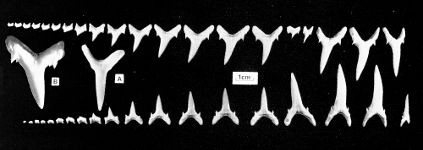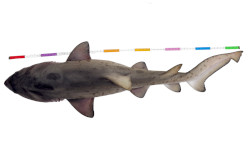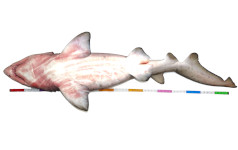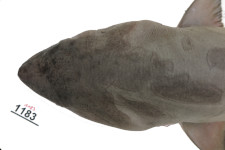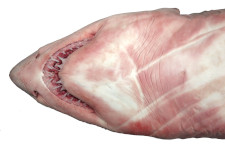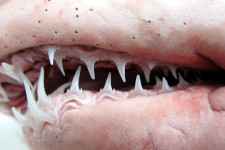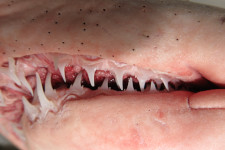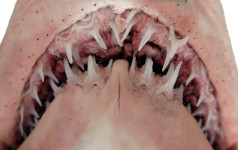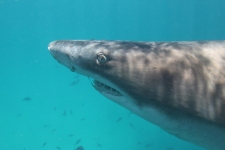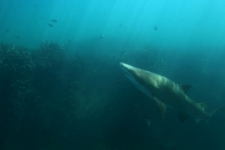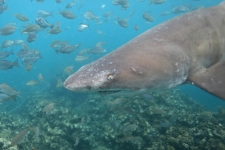Carcharias taurus
Rafinesque, 1810
Sand tiger shark
Classification: Elasmobranchii Lamniformes Carchariidae
Reference of the original description
Caratteri di alcuni nuovi generi e nuove specie di animali e pinate della Sicilia, con varie osservazioni sopra i medisimi, lère partie. (Part 1 involves fishes, pp. [i–iv] 3–69 [70 blank], Part 2 with slightly different title, pp. ia–iva + 71–105 [106 blank])
Caratteri di alcuni nuovi generi e nuove specie di animali e pinate della Sicilia, con varie osservazioni sopra i medisimi, lère partie. (Part 1 involves fishes, pp. [i–iv] 3–69 [70 blank], Part 2 with slightly different title, pp. ia–iva + 71–105 [106 blank])
Synonyms / new combinations and misspellings
Carcharhinus taurus, Carcharias aff. taurus, Carcharias americanus, Carcharias arenarius, Carcharias cf. taurus, Carcharias cf. tricuspidatus, Carcharias cuspidatus., Carcharias griseus, Carcharias littoralis, Carcharias owstoni, Carcharias platensis, Carcharias tricuspidatus, Carcharias (Odontaspis) taurus, Carcharias (Parodontaspis) platensis, Carcharodon taurus, Charcharias taurus, Eugomphodus cf. taurus, Eugomphodus littoralis, Eugomphodus taurus, Eugomphodus tricuspidatus, Lamna ecarinata, Odontaspis americanus, Odontaspis arenarius, Odontaspis cf. taurus, Odontaspis cf. tricuspidatus, Odontaspis cinerea, Odontaspis littoralis, Odontaspis platensis, Odontaspis taurus, Odontaspis tricuspidata, Odontaspis tricuspidatus, Squalus americanus., Squalus littoralis, Squalus littoralis., Squalus macrodus, Synodontaspis aff. taurus
Carcharhinus taurus, Carcharias aff. taurus, Carcharias americanus, Carcharias arenarius, Carcharias cf. taurus, Carcharias cf. tricuspidatus, Carcharias cuspidatus., Carcharias griseus, Carcharias littoralis, Carcharias owstoni, Carcharias platensis, Carcharias tricuspidatus, Carcharias (Odontaspis) taurus, Carcharias (Parodontaspis) platensis, Carcharodon taurus, Charcharias taurus, Eugomphodus cf. taurus, Eugomphodus littoralis, Eugomphodus taurus, Eugomphodus tricuspidatus, Lamna ecarinata, Odontaspis americanus, Odontaspis arenarius, Odontaspis cf. taurus, Odontaspis cf. tricuspidatus, Odontaspis cinerea, Odontaspis littoralis, Odontaspis platensis, Odontaspis taurus, Odontaspis tricuspidata, Odontaspis tricuspidatus, Squalus americanus., Squalus littoralis, Squalus littoralis., Squalus macrodus, Synodontaspis aff. taurus
Types
Carcharias taurus
XXXX: No types known;
Carcharias arenarius
Holotype: QM: I.1884
Carcharias griseus
XXXX: No types known;
Carcharias owstoni
Holotype: MCZ: 1278-S (ex Owston #21252)
Carcharias tricuspidatus
Holotype: ZSI: 2337 or 2772 (apparently lost)
Lamna ecarinata
Holotype: ZMB: 4532
Squalus americanus.
XXXX: No types known;
Squalus littoralis
XXXX: No types known;
Squalus littoralis.
XXXX: No types known;
Squalus macrodus
XXXX: No types known;
Carcharias taurus
XXXX: No types known;
Carcharias arenarius
Holotype: QM: I.1884
Carcharias griseus
XXXX: No types known;
Carcharias owstoni
Holotype: MCZ: 1278-S (ex Owston #21252)
Carcharias tricuspidatus
Holotype: ZSI: 2337 or 2772 (apparently lost)
Lamna ecarinata
Holotype: ZMB: 4532
Squalus americanus.
XXXX: No types known;
Squalus littoralis
XXXX: No types known;
Squalus littoralis.
XXXX: No types known;
Squalus macrodus
XXXX: No types known;
Description :
Citation: Carcharias taurus Rafinesque, 1810: In: Database of modern sharks, rays and chimaeras, www.shark-references.com, World Wide Web electronic publication, Version 12/2025
Please send your images of "Carcharias taurus" to info@shark-references.com
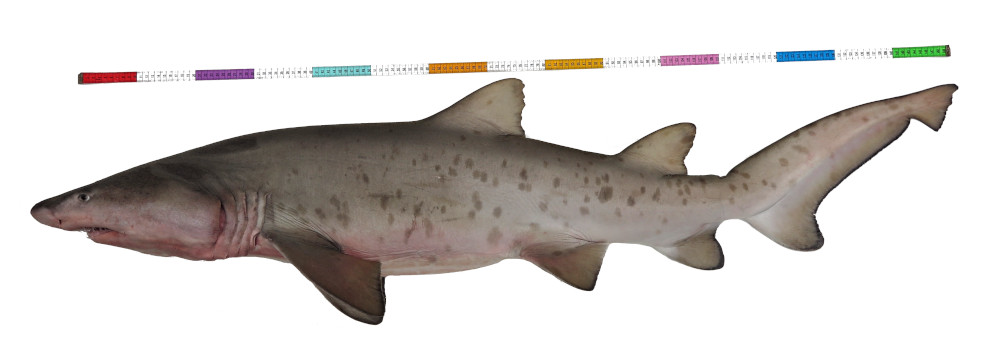
Carcharias taurus Rafinesque, 1810, ERB 1183, female, 153, 0 cm TL, Port Alfred, South Africa © Frederik H. Mollen (Elasmobranch Research Belgium)

Carcharias taurus Rafinesque, 1810, ERB 1183, female, 153, 0 cm TL, Port Alfred, South Africa © Frederik H. Mollen (Elasmobranch Research Belgium)
Common names
 Grauer Sandhai,
Grauer Sandhai,  Sandhai,
Sandhai,  Sandtiger,
Sandtiger,  Bacota,
Bacota,  Pez toro,
Pez toro,  Pintado,
Pintado,  Sandtiger shark,
Sandtiger shark,  Sarda,
Sarda,  Tiburón arenero,
Tiburón arenero,  Tiburón arenero tigre,
Tiburón arenero tigre,  Tiburón sarda,
Tiburón sarda,  Tiburón toro,
Tiburón toro,  Tigre arenero,
Tigre arenero,  Torito,
Torito,  Toro bacota,
Toro bacota,  Chien de mer,
Chien de mer,  Requin,
Requin,  Requin des sables,
Requin des sables,  Requin taureau,
Requin taureau,  Requin-taureau,
Requin-taureau,  Blue nurse shark,
Blue nurse shark,  Blue-nurse sand tiger,
Blue-nurse sand tiger,  Dogfish shark,
Dogfish shark,  Gray nurse shark,
Gray nurse shark,  Grey Nurse Shark,
Grey Nurse Shark,  Grey nurse,
Grey nurse,  Greynurse shark,
Greynurse shark,  Ground shark,
Ground shark,  Nuss shark,
Nuss shark,  Ragged tooth shark,
Ragged tooth shark,  Sand shark,
Sand shark,  Sand tiger,
Sand tiger,  Sand tiger shark,
Sand tiger shark,  Sand-tiger,
Sand-tiger,  Sandtiger shark,
Sandtiger shark,  Shovel-nosed shark,
Shovel-nosed shark,  Slender-tooth shark,
Slender-tooth shark,  Spotted ragged-tooth,
Spotted ragged-tooth,  Spotted ragged-tooth shark,
Spotted ragged-tooth shark,  Spotted raggedtooth,
Spotted raggedtooth,  Spotted raggedtooth shark,
Spotted raggedtooth shark,  Spotted sand tiger shark,
Spotted sand tiger shark,  Pisci tauru,
Pisci tauru,  Squalo toro,
Squalo toro,  Caçoa,
Caçoa,  Cação-da-areia,
Cação-da-areia,  Cação-de-areia,
Cação-de-areia,  Cação-galhudo,
Cação-galhudo,  Cação-magonga,
Cação-magonga,  Cação-mangona,
Cação-mangona,  Cação-mangonga,
Cação-mangonga,  Cação-manogonga,
Cação-manogonga,  Dentudo,
Dentudo,  Magonga,
Magonga,  Mangona,
Mangona,  Mangonga,
Mangonga,  Tubarão de areia,
Tubarão de areia,  Tubarão-,
Tubarão-,  Tubarão-amarelo,
Tubarão-amarelo,  Tubarão-dentudo,
Tubarão-dentudo,  Tubarão-toiro, Tawru (malta)
Tubarão-toiro, Tawru (malta)
 Grauer Sandhai,
Grauer Sandhai,  Sandhai,
Sandhai,  Sandtiger,
Sandtiger,  Bacota,
Bacota,  Pez toro,
Pez toro,  Pintado,
Pintado,  Sandtiger shark,
Sandtiger shark,  Sarda,
Sarda,  Tiburón arenero,
Tiburón arenero,  Tiburón arenero tigre,
Tiburón arenero tigre,  Tiburón sarda,
Tiburón sarda,  Tiburón toro,
Tiburón toro,  Tigre arenero,
Tigre arenero,  Torito,
Torito,  Toro bacota,
Toro bacota,  Chien de mer,
Chien de mer,  Requin,
Requin,  Requin des sables,
Requin des sables,  Requin taureau,
Requin taureau,  Requin-taureau,
Requin-taureau,  Blue nurse shark,
Blue nurse shark,  Blue-nurse sand tiger,
Blue-nurse sand tiger,  Dogfish shark,
Dogfish shark,  Gray nurse shark,
Gray nurse shark,  Grey Nurse Shark,
Grey Nurse Shark,  Grey nurse,
Grey nurse,  Greynurse shark,
Greynurse shark,  Ground shark,
Ground shark,  Nuss shark,
Nuss shark,  Ragged tooth shark,
Ragged tooth shark,  Sand shark,
Sand shark,  Sand tiger,
Sand tiger,  Sand tiger shark,
Sand tiger shark,  Sand-tiger,
Sand-tiger,  Sandtiger shark,
Sandtiger shark,  Shovel-nosed shark,
Shovel-nosed shark,  Slender-tooth shark,
Slender-tooth shark,  Spotted ragged-tooth,
Spotted ragged-tooth,  Spotted ragged-tooth shark,
Spotted ragged-tooth shark,  Spotted raggedtooth,
Spotted raggedtooth,  Spotted raggedtooth shark,
Spotted raggedtooth shark,  Spotted sand tiger shark,
Spotted sand tiger shark,  Pisci tauru,
Pisci tauru,  Squalo toro,
Squalo toro,  Caçoa,
Caçoa,  Cação-da-areia,
Cação-da-areia,  Cação-de-areia,
Cação-de-areia,  Cação-galhudo,
Cação-galhudo,  Cação-magonga,
Cação-magonga,  Cação-mangona,
Cação-mangona,  Cação-mangonga,
Cação-mangonga,  Cação-manogonga,
Cação-manogonga,  Dentudo,
Dentudo,  Magonga,
Magonga,  Mangona,
Mangona,  Mangonga,
Mangonga,  Tubarão de areia,
Tubarão de areia,  Tubarão-,
Tubarão-,  Tubarão-amarelo,
Tubarão-amarelo,  Tubarão-dentudo,
Tubarão-dentudo,  Tubarão-toiro, Tawru (malta)
Tubarão-toiro, Tawru (malta)
Short Description
A shark with a short, pointed snout, small eyes, protruding spike-like teeth and small, equal-sized dorsal and anal fins; 1st dorsal fin closer to pelvic than to pectoral fins [536]. Caudal fin with a pronounced subterminal notch and a short ventral lobe [16823]. Pale brown or grey, paler below, with dark spots that appear faded in adults; fins plain (Ref. 6586).
A shark with a short, pointed snout, small eyes, protruding spike-like teeth and small, equal-sized dorsal and anal fins; 1st dorsal fin closer to pelvic than to pectoral fins [536]. Caudal fin with a pronounced subterminal notch and a short ventral lobe [16823]. Pale brown or grey, paler below, with dark spots that appear faded in adults; fins plain (Ref. 6586).
Distribution
Found in all warm seas except perhaps the eastern Pacific [544]. Indo-West Pacific: Red Sea and off South Africa to Japan, Korea and Australia [544]. Present in Arafura Sea (Ref. 9819). Western Atlantic: Gulf of Maine to Argentina. Old record from Bermuda, south Brazil [17659]. Eastern Atlantic: Mediterranean to Cameroon. Northwest Atlantic: Canada (Ref. 5951). First record: 2013: United Arab Emirates waters (female, 256 cm, off Dalma Island) [17946]; Source: www.gbif.org
Found in all warm seas except perhaps the eastern Pacific [544]. Indo-West Pacific: Red Sea and off South Africa to Japan, Korea and Australia [544]. Present in Arafura Sea (Ref. 9819). Western Atlantic: Gulf of Maine to Argentina. Old record from Bermuda, south Brazil [17659]. Eastern Atlantic: Mediterranean to Cameroon. Northwest Atlantic: Canada (Ref. 5951). First record: 2013: United Arab Emirates waters (female, 256 cm, off Dalma Island) [17946]; Source: www.gbif.org
Human uses
fisheries: commercial; gamefish: yes
fisheries: commercial; gamefish: yes
Biology
Exhibit ovoviparity (aplacental viviparity), with embryos feeding on other ova produced by the mother (oophagy) after the yolk sac is absorbed, then cannibalize siblings (adelphophagy) [733]. Distinct pairing with embrace [17086]. Eggs leave the ovaries, and while in transit in the oviducts are fertilized and enclosed in groups of 16 to 23 in egg cases. However, at some time between fertilization and birth only two (Ref. 5578, 6586) embryos of its group prevails, possibly by devouring its rivals, and proceeds to eat fertilized eggs and smaller potential siblings in utero until birth. According to Springer (1948) (Ref. 39565), it is evident that this species sends forth into the world not only large, well-developed, and even experienced young but may send them forth with a full stomach. The yolk sac is resorbed at a small size, less than 17 cm, and the umbilical scar may be lost. Gestation period may be from 8 to 9 months long. Size at birth 100 cm (Ref. 6586). Pratt (2001) (Ref. 49562) relates Gordon"quot;s (1993) (Ref. 51113) detailed account of the mating behavior of the sand tiger sharks as follows: "mating activities began when the two male C. taurus, having become reluctant to feed, increased their swimming speed, accompanied by clasper flexion and eventual interest in their female tank mates...aggressive displays such as snapping and stalking became frequent, mostly toward species of smaller Carcharhinus in the tank. The males did not become interested in the female until she slowed, moved to the sand area and started cupping her pelvic fins. The two males then became competitive toward each other, circling and tailing, until the alpha male forced the beta male out of the sand area. The female bit the male prior to copulation. She exhibited shielding behavior for several days and then resumed cupping and flaring. The female gradually changed her swimming position and began displaying the submissive behavior. The alpha male swam in increasingly larger circles and began splaying its claspers, then approached the female and exhibited tailing and nosing. Copulation occurred as the male bit into the right flank and trailing edge of the pectoral fin of the female. The male swam side by side with the female, copulating with the right clasper for one to two minutes. After copulation, the male showed little interest in the female." In captivity, males show aggression toward other species after copulation (Ref. 51113, 49562). Females avoid patrolling males by "quot;shielding"quot; with pelvics close to the substrate (Ref. 51113, 49562). However, female acceptance of future male partner is indicated by a show of "quot;submissive"quot; body, "quot;cupping"quot; and "quot;flaring"quot; of pelvic fins (Ref. 51113, 49562). A carnivore [17641].
Exhibit ovoviparity (aplacental viviparity), with embryos feeding on other ova produced by the mother (oophagy) after the yolk sac is absorbed, then cannibalize siblings (adelphophagy) [733]. Distinct pairing with embrace [17086]. Eggs leave the ovaries, and while in transit in the oviducts are fertilized and enclosed in groups of 16 to 23 in egg cases. However, at some time between fertilization and birth only two (Ref. 5578, 6586) embryos of its group prevails, possibly by devouring its rivals, and proceeds to eat fertilized eggs and smaller potential siblings in utero until birth. According to Springer (1948) (Ref. 39565), it is evident that this species sends forth into the world not only large, well-developed, and even experienced young but may send them forth with a full stomach. The yolk sac is resorbed at a small size, less than 17 cm, and the umbilical scar may be lost. Gestation period may be from 8 to 9 months long. Size at birth 100 cm (Ref. 6586). Pratt (2001) (Ref. 49562) relates Gordon"quot;s (1993) (Ref. 51113) detailed account of the mating behavior of the sand tiger sharks as follows: "mating activities began when the two male C. taurus, having become reluctant to feed, increased their swimming speed, accompanied by clasper flexion and eventual interest in their female tank mates...aggressive displays such as snapping and stalking became frequent, mostly toward species of smaller Carcharhinus in the tank. The males did not become interested in the female until she slowed, moved to the sand area and started cupping her pelvic fins. The two males then became competitive toward each other, circling and tailing, until the alpha male forced the beta male out of the sand area. The female bit the male prior to copulation. She exhibited shielding behavior for several days and then resumed cupping and flaring. The female gradually changed her swimming position and began displaying the submissive behavior. The alpha male swam in increasingly larger circles and began splaying its claspers, then approached the female and exhibited tailing and nosing. Copulation occurred as the male bit into the right flank and trailing edge of the pectoral fin of the female. The male swam side by side with the female, copulating with the right clasper for one to two minutes. After copulation, the male showed little interest in the female." In captivity, males show aggression toward other species after copulation (Ref. 51113, 49562). Females avoid patrolling males by "quot;shielding"quot; with pelvics close to the substrate (Ref. 51113, 49562). However, female acceptance of future male partner is indicated by a show of "quot;submissive"quot; body, "quot;cupping"quot; and "quot;flaring"quot; of pelvic fins (Ref. 51113, 49562). A carnivore [17641].
Size / Weight / Age
320 cm TL (male/unsexed; (Ref. 5213)); max. published weight: 158.8 kg (Ref. 40637)
320 cm TL (male/unsexed; (Ref. 5213)); max. published weight: 158.8 kg (Ref. 40637)
Habitat
reef-associated; oceanodromous [17660]; marine; depth range 1 - 191 m [518], usually 15 - 25 m [531]
reef-associated; oceanodromous [17660]; marine; depth range 1 - 191 m [518], usually 15 - 25 m [531]
Remarks
shark-references Species-ID=1045;
shark-references Species-ID=1045;
Parasites (arranged by Jürgen Pollerspöck)
Myxosporea
Monogenea
Cestoda
Trematoda
Nematoda
Copepoda
Hirudinea
Myxosporea
- Ceratomyxa curvata Cunha & Fonseca, 1918 [21233]
- Chloromyxum africanum Lisnerova, Martinek, Alama-Bermejo, Bouberlova, Schaeffner, Nkabi, Holzer & Bartosova-Sojkova, 2022 [31228]
Monogenea
- Udonella myliobati (Guberlet, 1936) [15299]
Cestoda
- Crossobothrium dohrnii (Oerley, 1885) Ruhnke, 1996 [24956] [11635] [16443]
- Crossobothrium laciniatum Linton, 1889 [16200] [16929]
- Crossobothrium sp. [25840]
- Grillotia erinaceus (Van Beneden, 1858) [16112]
- Grillotia sp. [16112]
- Pintneriella musculicola Yamaguti, 1934 [16210] [16112]
- Scyphophyllidium musteli (Van Beneden, 1850) [16443]
Trematoda
- Multicalyx cristata Faust & Tang, 1936 [27172]
Nematoda
Copepoda
- Achtheinus oblongus Wilson, 1908 [15303]
- Achtheinus pinguis Wilson, 1912 [22641] [27172]
- Alebion carchariae Krøyer, 1863 [7660] [15303] [27172]
- Alebion crassus (Bere, 1936) [12586]
- Alebion difficile (Van Beneden, 1892) [26820]
- Alebion gracilis Wilson, 1905 [14785] [29995]
- Anthosoma crassum (Abildgaard, 1794) [14785] [15305] [27172]
- Caligus elongatus Von Nordmann, 1832 [15305]
- Caligus furcisetifer Redkar, Rangnekar & Murti, 1949 [15299] [15303] [15305] [27172] [29995]
- Eudactylinodes niger (Wilson, 1905) [16931] [12586] [27172]
- Nemesis robusta (Van Beneden, 1851) [16606]
- Nesippus orientalis Heller, 1868 [15304] [15284] [27172]
- Pandarus floridanus Cressey, 1967 [7660] [15303] [27172]
- Pandarus satyrus Dana, 1849 [33255]
- Pandarus sinuatus Say, 1818 [16606] [33255]
- Pandarus smithii Rathbun, 1886 [14785] [7660] [15303] [27172]
- Pandarus sp. [27172]
Hirudinea
- Pontobdella moorei Oka, 1910 [8262]








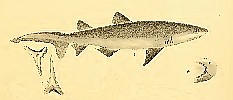

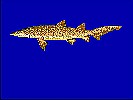
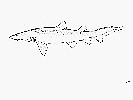
.jpg)
.jpg)
.jpg)
.jpg)
valid_as_Carcharias_taurus(in_MUELLER&HENLE,1839).jpg)
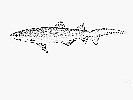
.JPG)
.JPG)
.JPG)
.JPG)
.JPG)
.JPG)

